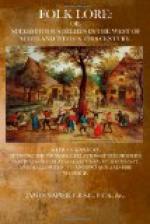If the nails of a child were cut before it was a year old, the chances were that it would grow up a thief.
To spill salt while handing it to any one was unlucky, a sign of an impending quarrel between the parties; but if the person who spilled the salt carefully lifted it up with the blade of a knife, and cast it over his or her shoulder, all evil consequences were prevented. In Leonardo de Vinci’s celebrated painting of the Last Supper, the painter has indicated the enmity of Judas by representing him in the act of upsetting the salt dish, with the right hand resting on the table, grasping the bag.
If a double ear of corn were put over the looking glass, it prevented the house from being struck by lightning. I have seen corn stalks hung over a looking glass, and was told that it brought luck.
It was customary for farmers to leave a portion of their fields uncropped, which was a dedication to the evil spirit, and called good man’s croft. The Church exerted itself for a long time to abolish this practice, but farmers, who are generally very superstitious, were afraid to discontinue the practice for fear of ill luck. I remember a farmer as late as 1825 always leaving a small piece of a field uncropped, but then did not know why. At length he gave the right of working these bits to a poor labourer, who did well with it, and in a few years the farmer cultivated the whole himself.
Water that had been used in baptism was believed to have virtue to cure many distempers. It was a preventive against witchcraft, and eyes bathed with it would never see a ghost.
To see a dot of soot hanging on the bars of the grate indicated a visit from a stranger. By clapping the hands close to it, if the current produced by this, blew it off at the first clap, the stranger would visit that day. Every clap indicated the day before the visit would be made. This is still a common practice, of which the following lines taken from Glasgow Weekly Herald, 1877, is a graphic illustration:—
“Rab—
Eh! Willie, come your
wa’s, and peace be wi’ ye;
Wi’ a’ my heart,
I’m truly glad to see ye.
Wee Geordie, wha sat gazing
in the fire,
In that prophetic mood I oft
admire,
Declar’d he saw a stranger
on the grate—
And Geordie’s auguries
are true as fate.
He gied his hands a dap wi’
a’ his micht,
And said that stranger’s
coming here the nicht,
Wi’ the first clap it’s
off. Ye see how true
Appears the future on wee
Geordie’s view.
What’s in the wind,
or what may be the news,
That brings ye here, in heedless
waste o’ shoes?”




